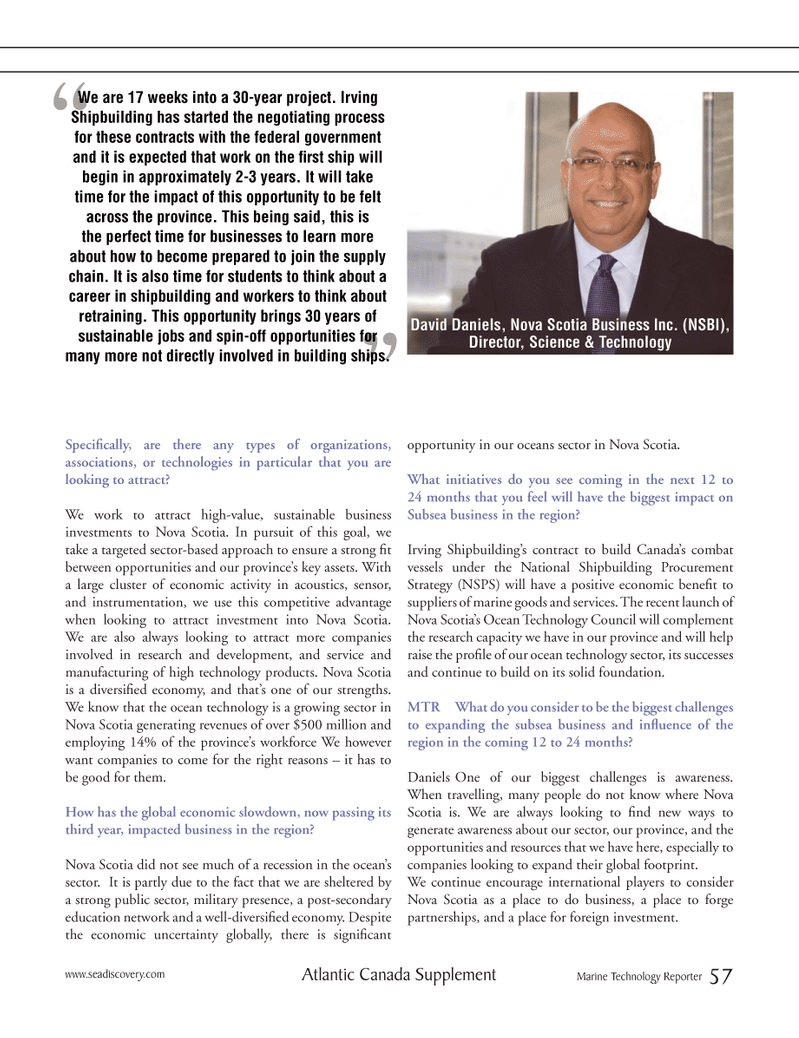
Page 57: of Marine Technology Magazine (March 2012)
Subsea Vehicle Report – Unmanned Underwater Systems
Read this page in Pdf, Flash or Html5 edition of March 2012 Marine Technology Magazine
SpeciÞ cally, are there any types of organizations, associations, or technologies in particular that you are looking to attract?We work to attract high-value, sustainable business investments to Nova Scotia. In pursuit of this goal, we take a targeted sector-based approach to ensure a strong Þ t between opportunities and our provinceÕs key assets. With a large cluster of economic activity in acoustics, sensor, and instrumentation, we use this competitive advantage when looking to attract investment into Nova Scotia. We are also always looking to attract more companies involved in research and development, and service and manufacturing of high technology products. Nova Scotia is a diversiÞ ed economy, and thatÕs one of our strengths. We know that the ocean technology is a growing sector in Nova Scotia generating revenues of over $500 million and employing 14% of the provinceÕs workforce We however want companies to come for the right reasons Ð it has to be good for them. How has the global economic slowdown, now passing its third year, impacted business in the region? Nova Scotia did not see much of a recession in the oceanÕs sector. It is partly due to the fact that we are sheltered by a strong public sector, military presence, a post-secondary education network and a well-diversiÞ ed economy. Despite the economic uncertainty globally, there is signiÞ cant opportunity in our oceans sector in Nova Scotia. What initiatives do you see coming in the next 12 to 24 months that you feel will have the biggest impact on Subsea business in the region? Irving ShipbuildingÕs contract to build CanadaÕs combat vessels under the National Shipbuilding Procurement Strategy (NSPS) will have a positive economic beneÞ t to suppliers of marine goods and services. The recent launch of Nova ScotiaÕs Ocean Technology Council will complement the research capacity we have in our province and will help raise the proÞ le of our ocean technology sector, its successes and continue to build on its solid foundation. MTR What do you consider to be the biggest challenges to expanding the subsea business and inß uence of the region in the coming 12 to 24 months? Daniels One of our biggest challenges is awareness. When travelling, many people do not know where Nova Scotia is. We are always looking to Þ nd new ways to generate awareness about our sector, our province, and the opportunities and resources that we have here, especially to companies looking to expand their global footprint. We continue encourage international players to consider Nova Scotia as a place to do business, a place to forge partnerships, and a place for foreign investment. Marine Technology Reporter 57Atlantic Canada Supplementwww.seadiscovery.com We are 17 weeks into a 30-year project. Irving Shipbuilding has started the negotiating process for these contracts with the federal government and it is expected that work on the Þ rst ship will begin in approximately 2-3 years. It will take time for the impact of this opportunity to be felt across the province. This being said, this is the perfect time for businesses to learn more about how to become prepared to join the supply chain. It is also time for students to think about a career in shipbuilding and workers to think about retraining. This opportunity brings 30 years of sustainable jobs and spin-off opportunities for many more not directly involved in building ships.?WW?or forhips.ips.David Daniels, Nova Scotia Business Inc. (NSBI), Director, Science & Technology MTR2 Canada Supplement 49-64.indd 57MTR2 Canada Supplement 49-64.indd 572/23/2012 10:26:13 AM2/23/2012 10:26:13 AM

 56
56

 58
58
